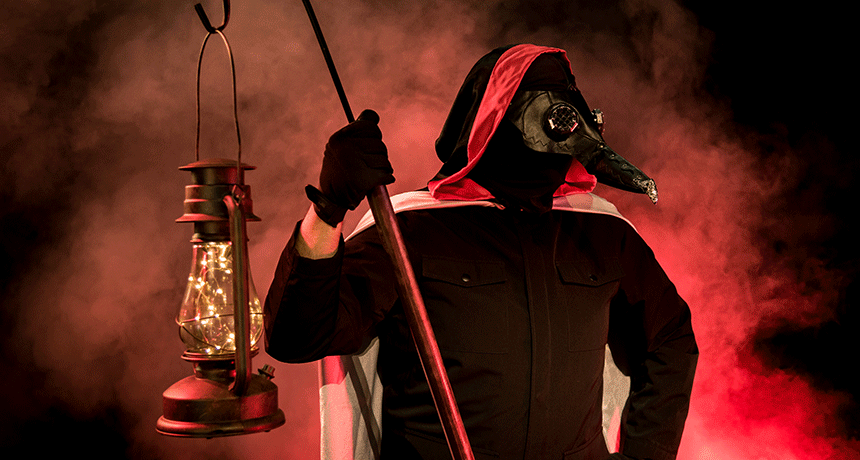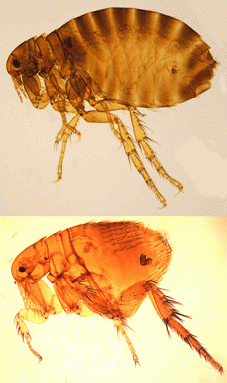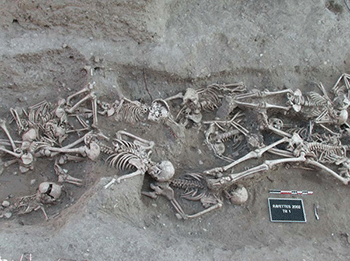Don’t blame the rats for spreading the Black Death
People — not rodents — may have spread the most famous plague in history

Towns suffering heavily from the Black Death in the 1300s often hired a plague doctor, illustrated here, to deal with their legions of sick and dying people. Such physicians often wore a beak-like mask filled with scented materials to cope with the smell of death all around.
Lpcornish/iStockphoto
The Black Death was one of the worst disease outbreaks in human history. This bacterial disease swept across Europe from 1346 to 1353, killing millions. For hundreds of years afterward, this plague returned. Each time, it risked wiping out families and towns. Many people thought rats were to blame. After all, their fleas can harbor the plague microbes. But a new study suggests researchers have given those rats too much blame. Human fleas, not rat fleas, may be most to blame for the Black Death.
Black Death was an especially extreme outbreak of bubonic plague.
Bacteria known as Yersinia pestis cause this disease. When these bacteria are not infecting people, they hang out in rodents, such as rats, prairie dogs and ground squirrels. Many rodents can become infected, explains Katharine Dean. She studies ecology — or how organisms relate to one another — at the University of Oslo in Norway.
The plague’s species “persists mostly because the rodents don’t get sick,” she explains. These animals can then form a reservoir for the plague. They serve as hosts in which these germs can survive.
Later, when fleas bite those rodents, they slurp up the germs. These fleas then spread those bacteria when they bite the next critter on their menu. Often, that next entrée is another rodent. But sometimes, it’s a person. “Plague is not picky,” notes Dean. “It’s amazing that it can live with so many hosts and in different places.”
People can become infected with the plague in three different ways. They can be bitten by a rat flea that’s carrying plague. They can be bitten by a human flea carrying the plague. Or they can catch it from another person. (Plague can spread from person to person through an infected individual’s cough or vomit.) Scientists have been trying to figure out, though, which route was most responsible for the Black Death.
Flea vs. flea

The plague may not be a picky disease, but fleas can be picky eaters. Different species of these parasites are adapted to coexist with different animal hosts. People have their own flea: Pulex irritans. It’s an ectoparasite, meaning that it lives outside its host. People often have to deal with another ectoparasite, as well, a species of louse.
The black rats that lived in Europe during the Middle Ages have their own species of flea. It’s called Xenopsylla cheopis. (Another flea species targets the brown rat, which now dominates in Europe.) All these fleas and the louse can carry plague.
Rat fleas prefer to bite rats. But they won’t turn down a human meal if it’s closer. Ever since scientists proved that rat fleas could transmit plague, they assumed those fleas were behind the Black Death. Rat fleas bit people, and people got the plague.
Except that there has been growing evidence that black rats don’t spread plague fast enough to account for how many people died in the Black Death. For one, the fleas found on European black rats don’t like to bite people much.
If scientists needed another explanation, Dean and her colleagues had a candidate: human parasites.
Ancient manuscripts and modern computers
Dean’s team went digging for death records. “We were at the library a lot,” she says. The researchers looked through old books for records of how many people died of plague per day or per week. The records often were quite old and hard to read. “A lot of the records are in Spanish or Italian or Norwegian or Swedish,” Dean notes. “We were so lucky. Our group has so many people that speak so many different languages.”
The team calculated plague death rates from the 1300s to the 1800s for nine cities in Europe and Russia. They graphed the death rates in each city over time. Then the scientists created computer models of the three ways plague can spread — person to person (via human fleas and lice), rat to person (via rat fleas) or person to person (via coughing). Each model predicted what the deaths from each method of spread would look like. Person to person spread might trigger a very quick spike in deaths that fell off quickly. Rat flea-based plague might lead to fewer deaths but those deaths might occur over a long time. Death rates from human flea-based plague would fall somewhere in between.

Dean and her colleagues compared their model results to the patterns of real deaths. The model that assumed the disease was spread by human fleas and lice was the winner. It most closely matched the patterns in death rates seen from human transmissions. The scientists published their findings January 16 in the Proceedings of the National Academy of Sciences.
This study doesn’t exonerate rats. Plague is still around, hiding out in rodents. It probably spread from rats to human fleas and lice. From there, it sometimes prompted human outbreaks. Bubonic plague still emerges. In 1994, for example, rats and their fleas spread plague through India, killing almost 700 people.
Rats still spread a lot of plague, Dean explains. “Just probably not the Black Death. I feel more like a champion for the human ectoparasites,” she says. “They did a good job.”
Not a total surprise
Scientists have suspected that rat fleas might not have played a big role in the Black Death, says Michael Antolin. He is a biologist at Colorado State University in Fort Collins. “It’s nice to see a model that shows [it could happen].”
Studying illnesses of the past is important for the future, Antolin notes. Those long-ago outbreaks can teach a lot about how modern diseases might spread and kill. “What we’re looking for are the conditions that allow epidemics or pandemics to occur,” he says. “What can we learn? Can we predict the next big outbreak?”
Even if rats played a role in the Black Death, they wouldn’t have been the biggest factor, Antolin explains. Instead, environmental conditions that allowed rats, fleas and lice to spend so much time around people would have played a larger role.
Until modern times, he notes, people were gross. They didn’t wash often and there were no modern sewers. Not only that, rats and mice could thrive in the straw that many people used in their buildings for roofing and a floor covering. Hard roofs and clean floors mean fewer places for ratty roommates — and the diseases they might pass on to human fleas and lice.
What stops plague isn’t medicine or killing rats, Antolin says. “Sanitation is what fixes plague.”







